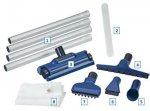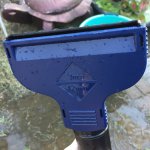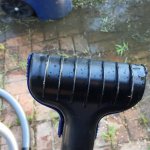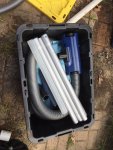OK, all.... If you're ready for a lengthy review/critique/fix, I'll post a series of cut & pastes of what I PM'd to
@bettasngoldfish. I "thumbnailed" the photos. I also red-highlighted the parts that I think are most important, or at least, these were the most valuable things that I learned.
MY PONDOVAC 4:
Overall, and after much trial and error, I think I'm going to like it a lot! You have read all the reviews, I'm sure, where customers complain about this or that, and you wonder [or at least I do] how much of that is simply because they didn't take the time to LEARN about the vac prior to purchase, etc., etc. And some reviews go into good detail explaining what worked; what didn't work; and/or how they resolved an issue. Those are the customers who did their homework. Unlike the ones who say that it didn't work.....and most of the time it's because they [apparently] didn't do their homework, or had unrealistic expectations, therefore didn't understand that the things they say "were broken," were actually the system doing its job properly.
I'll start off by telling you what was good and then I'll go into the problems I encountered / troubleshooting / resolution.
And the first of those is the 2-tank cycling system. What a life-saver, not having to stop and empty the tank every 30 seconds! It really does a great job of getting the muck up, and I love the clear plastic part of the handle so you can see what you're getting. Once I got over my learning curve, using it went smoothly. One of my fears was that it would pull too much water out, but it didn't. I liked the mesh bag because I like to see what all came out, for one thing, but mostly I like to be able to rescue any tadpoles or snails that got sucked in. I wouldn't, however, recommend using it for returning water to the pond [unless you were in a drought-stricken area where every drop of water was precious].
Oh, and another thing [and this is good to know] is that a lot of customers say that the suction stops when the unit is in discharge mode. This isn't true. When it's working properly, there is still some suction. IOW, when it goes into discharge mode, the crud that has collected in the tube DOES NOT drain back into the pond [as some have said]! When working properly, you'll see that the stuff in the tube remains suspended there, even with a little bit still going into the unit, then it flows on into the unit once it cycles back to suction mode. If/when it does release and flow back into the pond, it means there is something stuck somewhere which is restricting the suction.
Again, once you learn all the quirks, it was a breeze to use! Keep that in mind when I go into the next part......this is where all those negative customer reviews get their start.
OK, now for the nitty gritty! Where do I start.
- Be sure to PAY ATTENTION to which nozzle to use! I didn't understand their descriptions and it took me forever to realize that the "general purpose" one was the one I needed to use. This one has an adjustable opening and mostly they say it's for use in gravel. What they MEAN is that you can adjust the opening to keep from sucking up anything that will clog the system!



[[the Gen. Purpose one is #7 in the diagram]]
- Unless you use the "gen purpose" nozzle, trapdoor snails WILL clog the opening! And if they get past the opening [when I used different nozzles] they will clog somewhere else along the system's path. Sometimes it's the size of the snail; sometimes it's the position or angle that lodges the snail; sometimes it's a combination of several snails along with other crud. IF YOU HAVE TRAPDOOR SNAILS, USE THE GENERAL PURPOSE NOZZLE!!
- There are several places where "things" can get clogged. One is at the opening of the nozzle itself. Another is the slight angle in the handle part -- only a problem if it's a snail. Another is one of the flapper valves inside [again, this only happened with snails]. And last but not least, is if the discharge hose doesn't drain well [as in, there isn't enough slope for a gravity drain].
- Clogs mean you have to turn it off and start troubleshooting. After a while, I started to learn and understand what was going on if a certain thing happened. One example was if the suction stopped all together -- nothing going up the tube. Or, [once you got used to the suction patterns] I knew where to look for the problem -- like the exact location of the clog. Oh, and if you take it apart and fail to close the latches -- it won't suction......
- Once fitted together, the metal wand sections were extremely hard to pull apart -- and esp with wet hands. I could never get them apart and had to get Tim to help. They really need to either have some type of click-in arrangement for these, or at least have a grippy surface. And you want them to be connected snugly or else there's the danger that they'll separate on you in the pond -- that wouldn't be fun!
- The discharge hose -- where it connects to the unit -- is a push-in. It needs to be a twist-lock or click-in. There were times when the hose popped out and the gunk went everywhere it wasn't supposed to go!
OK, now for the analysis part!
Diagnosing clogs/loss of suction:
- If you totally lose suction, and nothing is coming UP the suction tube, it's probably a problem with the drain hose (dishcharge hose) being clogged. Our yard is fairly flat. The discharge hose is 10' long. There was no place to lay it where it would drain well, so any amt of gravel, snails, plant matter that collected inside would stop the flow. We ended up placing it on the edge of the pond [which you're not supposed to do] just to get enough grade. I am going to assemble a lt-wt platform to place it on for future use.
- You see something in the suction tube, but the unit isn't cycling [IOW, there is some suction taking place, but it's inadequate for the unit to cycle]. It's going to be that something is stuck (in the wand or suction hose). First thing I do is raise the nozzle end of the tube out of the water and hold it up as high as I can. If the clog is at the end of the tube, this will let gravity assist the suction and it pulls the stuff on down. If that doesn't work, I'll manually check the end and pull out anything that's stuck. If still no results, pull the clear section off the handle section and see if anything [snail] is stuck in the curve. If that's clear, while the parts are separated, peer down the wand section. If you see light, no clog. If there's no light, clog. And good luck pulling the wand sections apart! It that's clean next step is to unscrew the blue part that holds the suction intake hose. That's where there are 2 flapper valves -- check that nothing is stuck there. Usually, it's going to be one of those issues.
- Unfortunately, the only way I was able to clear a clog in the wand tubing or the bend in the handle [again, snail] was by ramming something into the opening.....and I really hated to hear that "crunch" sound, but it was the only solution
 . I've very kindhearted and hate to kill anything [except fire ants!].
. I've very kindhearted and hate to kill anything [except fire ants!].
- If the discharge hose pops off, it's because the discharge hose is clogged. Clear clog -- lifting sections of the hose and walking it to the end was usually sufficient. At first, to extend the length of the hose, we cobbled together some 2" PVC with a Fernco coupler, and then for even more length, tried to reduce it with 1 1/2" PVC, which was all we had left. Not a good idea -- reducing doesn't work! 99% of the time if there was a clog, it was at that junction. They sell extension hose for about $45, but I'm looking at getting something at Home Depot that I can use.
- Not a bad thing, but when using it, resist the temptation to zip along the bottom -- take it very slow. If you find a "crud pocket," stop there for a few cycles to be sure you got it all.
And that's all I can think of right now. Again, I spent hours with it, totally frustrated and agreeing with every negative customer review ever written. It was almost staying clogged more than it was sucking up crud. I was continuously taking things apart, or turning it off & on. This went on for HOURS!!!!! Until I tried the "general purpose" nozzle so that I could adjust the size of the opening -- and make it too small for the snails! That was what I should have used from the start! By then, it was getting late, I was tired, and the mosquitoes were getting thick. Most of the muck was gone, so I decided to call it quits.
NEXT POST -- A FOLLOW-UP:
And thought you might like a progress report on the Pondovac. I used it again yesterday, with a few modifications to how I set it up. So the hose would discharge in a better place [away from the driveway] so that I wouldn't have to use PVC pipe extensions, I moved it as far into the yard as the power cord would allow. With the long suction hose, it was still easy to access all areas of the pond. I also set it up on a pair of cinder blocks [increased the height by what, 8"] so the discharge hose would drain better. That did work, though, for some reason, I still had to turn it off a few times and manually clear the hose -- by picking it up and letting it flow toward the bag. Maybe next time I'll raise it just a tad more.
This time around was a great experience, using all of the info I learned. Of course, I didn't have as much to clean out this time, but in comparison, I only spent 45 minutes doing what took HOURS the first time around! With the "gen purp" tool, no snails, but I did have to hold the wand up every once in a while to clear the opening of some thicker stuff -- snails, branches, thick pieces of anacharis (sp?). But that was the only part that became clogged, just the opening, as nothing large enough got through to the unit. I had to play with that opening size a little bit -- you have to find that sweet spot. Also found that if things get stuck in the opening [you can tell by the way the suction changes] you can also open the slider on the wand handle which will instantly reduce the suction enough that whatever is stuck will fall away.
NEXT FOLLOW-UP:
Used it again, briefly yesterday. I wanted to try it out as a back flush for the turtle-bog -- IOW, use it to suck the crud out via the clean-out pipes. It worked pretty well. I have 1-1/2" PVC going to the bog, and the clear wand fit inside the clean-out tube.
Another thing I tried was using the slide that lets you control the amt of suction. I wanted to "vac" out the bog gravel, but there are a lot of tadpoles in the bog. Didn't want to vac them out and didn't want to suck up the gravel -- just suction the gravel, like doing a tank siphon. For that, I used the attachment #5, which I think is the so-called string algae attachment. I opened the slider and with it open all the way, it was sucking up the dirty water. I found that I could "fine tune" the amt of suction by just lightly placing [hovering] my finger over the hole without actually touching the wand -- that seemed to work better than physically touching the hole. It worked well [I left the water flowing into the bog].
Oh, and in their pics they show the hoses neatly wrapped around the unit for storage. Ours won't work like that. There are pegs for you to insert the 4 wand sections, and the hoses are supposed to wrap around the unit, and inside where the wands are. At least with ours, there isn't enough room to wrap the hoses. Even the smaller suction hose didn't fit without pushing out on the wands. Oh, well, no biggie, I guess.
 NEXT UPDATE:
NEXT UPDATE:
UPDATE:
In order to extend the length of the discharge hose w/out paying a fortune, I tried an experiment and it worked! The way the discharge hose is designed, a Fernco will fit over the end, but I found that when I attached a compatible length of PVC tubing, there was a problem -- I never figured that out, but I do know that you can't go smaller. I wanted some more flex hose, but Home Depot [the only place I looked] didn't have anything in 2". So I got a roll of "backwash hose" from the pool dept. Even 2" is a tad too small to fit over the end of the d/c hose, but it does fit with a little stretching. I added a clamp. Stretched the hose [50' which is what I needed to get the water in the right place] out, got all the kinks out, and made sure it was smooth. Worked like a charm! I only had to turn the vac off a couple of times, but usually [and guessing the stoppage was in the flapper valve] just turning it on & off again did the trick.
 Another issue I had was elevating the vac enough for the discharge to drain. A cinder block @ 8" wasn't quite tall enough. When I was at HD, I looked at their totes and found this one -- it's 11" tall and perfect, and it's strong enough to support the vac, plus I should be able to store some parts in it
Another issue I had was elevating the vac enough for the discharge to drain. A cinder block @ 8" wasn't quite tall enough. When I was at HD, I looked at their totes and found this one -- it's 11" tall and perfect, and it's strong enough to support the vac, plus I should be able to store some parts in it [haven't tried yet].


[[ADDITIONAL ENTRY: I
was able to get most of the attachments into the tote!!]]
Oh, and I tried something else, if it doesn't end up adversely effecting the pond.....
A tip from an Amazon.com reader, when I posted about the wand sections being hard to separate -- suggested spraying the ends with silicone. I didn't have anything like that, so I lightly greased the ends with Vaseline! It worked -- but if you try it, put the Vaseline on a tissue or something to apply it and don't use your fingers [like I did]. Once you get the Vaseline on your hands, they are too slippery from that.
END OF MY REVIEW! HOPE IT HELPS SOMEONE! I KNOW I WENT TO EXTREMES, BUT I REALLY DID WANT THE PONDOVAC TO WORK FOR ME -- AND IT TOOK SOME TRIALS, BUT I REALLY DO LIKE IT NOW THAT I'VE GIVEN IT A CHANCE!









